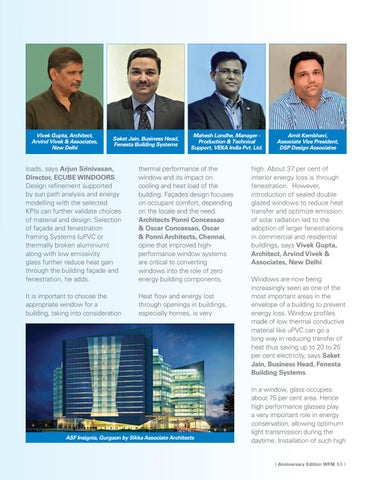Vivek Gupta, Architect, Arvind Vivek & Associates, New Delhi
Saket Jain, Business Head, Fenesta Building Systems
Mahesh Londhe, Manager Production & Technical Support, VEKA India Pvt. Ltd.
loads, says Arjun Srinivasan, Director, ECUBE WINDOORS. Design refinement supported by sun path analysis and energy modelling with the selected KPIs can further validate choices of material and design. Selection of faรงade and fenestration framing Systems (uPVC or thermally broken aluminium) along with low emissivity glass further reduce heat gain through the building faรงade and fenestration, he adds.
thermal performance of the window and its impact on cooling and heat load of the building. Faรงades design focuses on occupant comfort, depending on the locale and the need. Architects Ponni Concessao & Oscar Concessao, Oscar & Ponni Architects, Chennai, opine that improved highperformance window systems are critical to converting windows into the role of zero energy building components.
It is important to choose the appropriate window for a building, taking into consideration
Heat flow and energy lost through openings in buildings, especially homes, is very
ASF Insignia, Gurgaon by Sikka Associate Architects
Amit Kembhavi, Associate Vice President, DSP Design Associates
high. About 37 per cent of interior energy loss is through fenestration. However, introduction of sealed double glazed windows to reduce heat transfer and optimize emission of solar radiation led to the adoption of larger fenestrations in commercial and residential buildings, says Vivek Gupta, Architect, Arvind Vivek & Associates, New Delhi. Windows are now being increasingly seen as one of the most important areas in the envelope of a building to prevent energy loss. Window profiles made of low thermal conductive material like uPVC can go a long way in reducing transfer of heat thus saving up to 20 to 25 per cent electricity, says Saket Jain, Business Head, Fenesta Building Systems. In a window, glass occupies about 75 per cent area. Hence high performance glasses play a very important role in energy conservation, allowing optimum light transmission during the daytime. Installation of such high
l Anniversary Edition WFM 53 l
